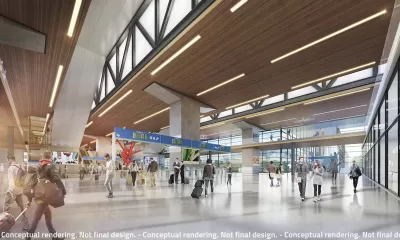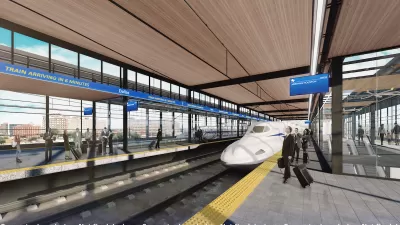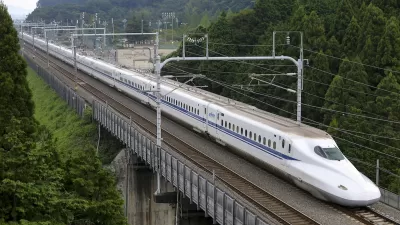While state leaders remain silent, federal transportation officials are touting the proposed project’s benefits.

Plans for a high-speed train between Dallas and Houston are becoming more and more real as passenger rail projects around the nation gain steam, reports Benjamin Schneider in Bloomberg CityLab. Texas Central, the authority overseeing the project, says the project would use Japanese Shinkansen technology, a type of high-speed rail not yet available in the United States.
“The 240-mile Dallas to Houston corridor, with a stop in the Brazos Valley serving Texas A&M University, is ideal for high-speed rail,” according to Amtrak’s Senior Vice President for High-Speed Rail Development Programs Andy Byford. But the project would cost upwards of $30 billion and require the acquisition of private property. Meanwhile, the state has remained silent on any level of financial support.
Hopes for the project, which was first proposed in 2009, grew last year when Amtrak and Texas Central announced they are ‘exploring’ a partnership that would have Amtrak operate the future line. “How, exactly, Texas Central and Amtrak would work together remains unclear.” A 2017 Texas law outlaws using state funds for privately operated high-speed rail, but Schneider points out that “It’s not clear whether an Amtrak-led but partially privately funded project would be barred from funding under this law.”
FULL STORY: The Dream of a Texas Bullet Train Lives On

Planetizen Federal Action Tracker
A weekly monitor of how Trump’s orders and actions are impacting planners and planning in America.

Congressman Proposes Bill to Rename DC Metro “Trump Train”
The Make Autorail Great Again Act would withhold federal funding to the system until the Washington Metropolitan Area Transit Authority (WMATA), rebrands as the Washington Metropolitan Authority for Greater Access (WMAGA).

The Simple Legislative Tool Transforming Vacant Downtowns
In California, Michigan and Georgia, an easy win is bringing dollars — and delight — back to city centers.

DC Backpedals on Bike Lane Protection, Swaps Barriers for Paint
Citing aesthetic concerns, the city is removing the concrete barriers and flexposts that once separated Arizona Avenue cyclists from motor vehicles.

In These Cities, Most New Housing is Under 441 Square Feet
With loosened restrictions on “micro-housing,” tiny units now make up as much as 66% of newly constructed housing.

Albuquerque’s Microtransit: A Planner’s Answer to Food Access Gaps
New microtransit vans in Albuquerque aim to close food access gaps by linking low-income areas to grocery stores, cutting travel times by 30 percent and offering planners a scalable model for equity-focused transit.
Urban Design for Planners 1: Software Tools
This six-course series explores essential urban design concepts using open source software and equips planners with the tools they need to participate fully in the urban design process.
Planning for Universal Design
Learn the tools for implementing Universal Design in planning regulations.
Smith Gee Studio
City of Charlotte
City of Camden Redevelopment Agency
City of Astoria
Transportation Research & Education Center (TREC) at Portland State University
US High Speed Rail Association
City of Camden Redevelopment Agency
Municipality of Princeton (NJ)





























